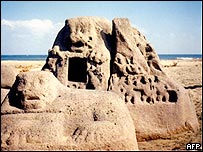02/14/2005: 
Urban Archaeology
Tsunami Uncovers Ancient Indian Port City
from The BBC The myths of Mahabalipuram were first set down in writing by British traveller J Goldingham, who visited the South Indian coastal town in 1798, at which time it was known to sailors as the Seven Pagodas.
The myths of Mahabalipuram were first set down in writing by British traveller J Goldingham, who visited the South Indian coastal town in 1798, at which time it was known to sailors as the Seven Pagodas.
The myths speak of six temples submerged beneath the waves with the seventh temple still standing on the seashore.
The myths also state that a large city which once stood on the site was so beautiful the gods became jealous and sent a flood that swallowed it up entirely in a single day.
Archaeologists say they have discovered some stone remains from the coast close to India's famous beachfront Mahabalipuram temple in Tamil Nadu state following the 26 December tsunami.
They believe that the "structures" could be the remains of an ancient and once-flourishing port city in the area housing the famous 1200-year-old rock-hewn temple.
Three pieces of remains, which include a granite lion, were found buried in the sand after the coastline receded in the area after the tsunami struck.
Archaeologists say that the stone remains date back to 7th Century AD and are nearly 6ft tall.
1 Annotation Submitted
Monday the 14th of February, awiggins noted:
Between the increasing number of “lost” coastal cities being found, and the fact that just about every culture on the planet has a flood “myth” it seems more and more likely that they all refer to the same event. Perhaps after the seas rise again, thousands of years from now, the survivors of this round of cataclysm will look back and wonder if there is any truth to the Legend of New York.


